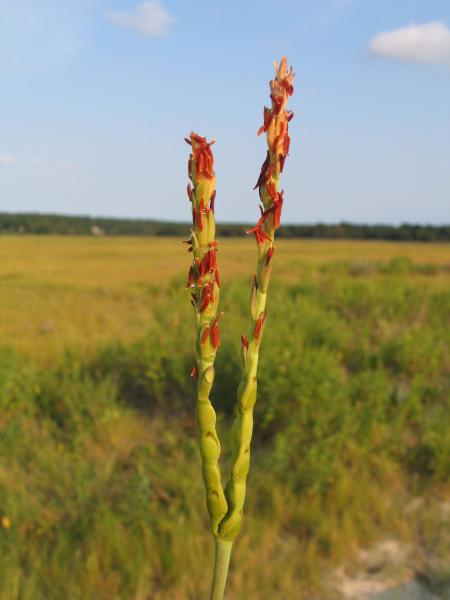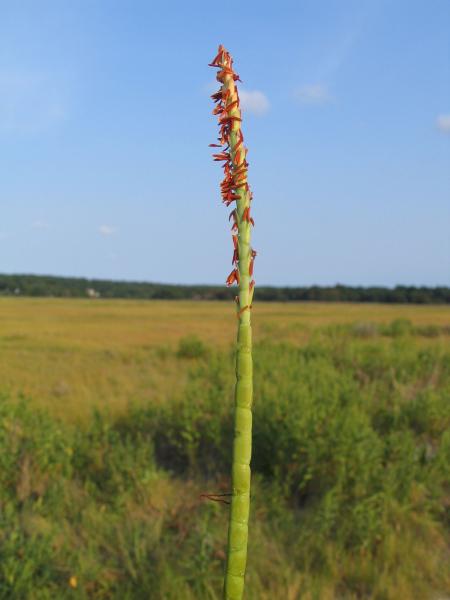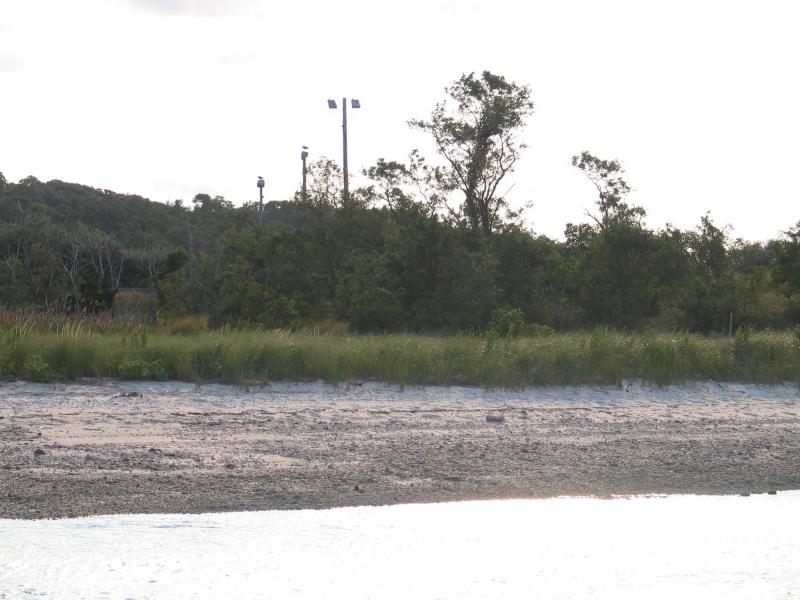Northern Gama Grass
Tripsacum dactyloides (L.) L.
- Class
- Monocotyledoneae (Monocots)
- Family
- Poaceae (Grass Family)
- State Protection
- Threatened
Listed as Threatened by New York State: likely to become Endangered in the foreseeable future. For animals, taking, importation, transportation, or possession is prohibited, except under license or permit. For plants, removal or damage without the consent of the landowner is prohibited.
- Federal Protection
- Not Listed
- State Conservation Status Rank
- S2
Imperiled in New York - Very vulnerable to disappearing from New York due to rarity or other factors; typically 6 to 20 populations or locations in New York, very few individuals, very restricted range, few remaining acres (or miles of stream), and/or steep declines.
- Global Conservation Status Rank
- G5
Secure globally - Common in the world; widespread and abundant (but may be rare in some parts of its range).
Summary
Did you know?
The federal plant materials center in Big Flats, New York has been growing northern gamma grass since the 1980s, when they began genetic experiments to improve the quality of the plants for cattle forage, site restoration, and biomass production (Salon and Dewald 2000). Plants found west of the coastal plain are not considered native to New York, because of this production and distribution.
State Ranking Justification
There are 11 existing populations but only two of them have hundreds of plants. Most occurrences are very small in area. One occurrence from 1988 was extirpated by Phragmites. There are 10 other historical occurrences.
Short-term Trends
Populations seem stable, but not enough work has been done to resurvey current populations to add to trend information.
Long-term Trends
The number of populations has probably remained about the same over time, although historical populations were probably larger in size because they were less constricted by development.
Conservation and Management
Threats
Exotic invasive species are the main threats to this grass, especially common reed (Phragmites australis) invading salt marsh habitats.
Conservation Strategies and Management Practices
This species needs disturbance to reduce competition from woody plants or more aggressive herbaceous plants, but too much direct disturbance to the plants will reduce or eliminate the population. Its habitat could be disturbed in the non-growing season to open it up for seed germination and colonization, but direct disturbance should be prevented during the growing season.
Research Needs
Genetic studies could be done to distinguish populations that have been introduced for livestock or erosion control from native populations.
Habitat
Habitat
In New York, Tripsacum dactyloides has been collected in a variety of habitats near the coast, including high salt marsh, wet meadows, oak forests, old fields, roadsides, and dunes (New York Natural Heritage Program 2010). Water courses and limestone outcrops (FNA 2003). Swamps and wet soil (Gleason and Cronquist 1991).
Associated Ecological Communities
- Brackish meadow*
(guide)
A moist, moderately well-drained brackish (salinity 0.5-18 ppt) perennial grassland with occasional isolated shrubs that is typically situated in a belt at the upper edge of salt marshes bordering sandy uplands, but may occupy large portions of interdunal basins. The community usually develops in areas with a unique combination of soils and hydrology, on deep deposits of periodically windblown or overwashed gleyed sands that are usually flooded only during spring tides and during major coastal storms, approximately two to three times per year.
- Brackish tidal marsh*
(guide)
A marsh community that occurs where water salinity ranges from 0.5 to 18.0 ppt, and water is less than 2 m (6 ft) deep at high tide. The vegetation in a brackish tidal marsh is dense and dominated by tall grass-like plants.
- Coastal oak-heath forest*
(guide)
A low diversity, large patch to matrix, hardwood forest that typically occurs on dry, well-drained, sandy soils of glacial outwash plains or moraines of the Atlantic Coastal Plain. The forest is usually codominated by two or more species of scarlet oak, white oak, and black oak.
- Hempstead Plains grassland*
(guide)
A tall grassland community that occurs on rolling outwash plains in west-central Long Island. This community occurs inland, beyond the influence of offshore winds and salt spray.
- High salt marsh
(guide)
A coastal marsh community that occurs in sheltered areas of the seacoast, in a zone extending from mean high tide up to the limit of spring tides. It is periodically flooded by spring tides and flood tides. High salt marshes typically consist of a mosaic of patches that are mostly dominated by a single graminoid species.
- Low salt marsh*
(guide)
A coastal marsh community that occurs in sheltered areas of the seacoast, in a zone extending from mean high tide down to mean sea level or to about 2 m (6 ft) below mean high tide. It is regularly flooded by semidiurnal tides. The mean tidal range of low salt marshes on Long Island is about 80 cm, and they often form in basins with a depth of 1.6 m or greater.
- Maritime dunes
(guide)
A community dominated by grasses and low shrubs that occurs on active and stabilized dunes along the Atlantic coast. The composition and structure of the vegetation is variable depending on stability of the dunes, amounts of sand deposition and erosion, and distance from the ocean.
- Maritime post oak forest*
(guide)
An oak-dominated forest that borders salt marshes or occurs on exposed bluffs and sand spits within about 200 meters of the seacoast. The trees may be somewhat stunted and flat-topped from pruning by salt spray and wind exposure. The forest is usually dominated by two or more species of oaks, including post oak, black oak, scarlet oak, and white oak.
- Mowed roadside/pathway
A narrow strip of mowed vegetation along the side of a road, or a mowed pathway through taller vegetation (e.g., meadows, old fields, woodlands, forests), or along utility right-of-way corridors (e.g., power lines, telephone lines, gas pipelines). The vegetation in these mowed strips and paths may be dominated by grasses, sedges, and rushes; or it may be dominated by forbs, vines, and low shrubs that can tolerate infrequent mowing.
- Sea level fen*
(guide)
A wetland that occurs at the upper edge of salt marshes but is fed primarily by acidic groundwater seeping out along the upland edge. This fresh water sometimes mixes with salt or brackish water during unusually high tides. There is a high abundance of sedges that decompose slowly and create a deep substrate of peat. This peat is underlain by deep sand or gravel. These fens usually have a high diversity of herbs but may also have scattered trees and shrubs.
- Sedge meadow*
(guide)
A wet meadow community that has organic soils (muck or fibrous peat). Soils are permanently saturated and seasonally flooded. The dominant herbs must be members of the sedge family, typically of the genus Carex.
- Sinkhole wetland
A small wetland, with or without a pond (a sinkhole pond), that occurs in a poorly drained sinkhole, typically underlain by limestone. Water levels fluctuate seasonally. In some areas there are many sinkholes in a group that are hydrologically connected underground, even though they are clearly separate at the ground surface.
* probable association but not confirmed.
Associated Species
- Dichanthelium acuminatum
- Elymus repens (quack grass)
- Elymus virginicus var. halophilus (coastal Virginia wild-rye)
- Iris prismatica (slender blue iris, slender blue flag)
- Juniperus virginiana
- Robinia pseudoacacia (black locust)
- Schizachyrium scoparium
- Spartina alterniflora (smooth cord grass)
- Trichostema dichotomum (blue-curls)
- Tridens flavus
- Viburnum acerifolium (maple-leaved viburnum)
Range
New York State Distribution
This grass is native from Orange County south through New York City to Eastern Long Island. It is now considered extirpated in Brooklyn. It is also distributed by the Natural Resources Conservation Service in Central and Western New York for planting as cattle forage. It has also turned up in seed mixes for restoration projects.
Global Distribution
This grass grows in the Atlantic Coast States from Massachusetts south through Florida. It extends west from the Virginias to Southeastern Nebraska and Eastern Kansas south through Texas.
Identification Comments
General Description
Northern Gamma Grass has clumped stems from 1 to 2 meters tall. The leaf blades are 30 to 75 cm long, 9 to 35 mm wide, and flat. The infloresence is terminal, with normally 2 to 3 erect branches, each 12 to 25 cm long. The pistillate spikelets are 6 to 8 mm long and 3 to 4.4 mm wide, below and more tightly compacted into the same raceme as the staminate spikelets (FNA 2003).
Best Life Stage for Proper Identification
Northern Gmma Grass is most easily identified in flower or fruit, though vegetative individuals may also be identified.
Similar Species
Tripsacum dactyloides is the only member of the genus in New York. Its wide leaves and terminal infloresence with long (12-25 cm) branches are distinctive.
Best Time to See
Eastern Gamma Grass flowers in July and August and the fruiting plants persist into November.
- Flowering
- Fruiting
The time of year you would expect to find Northern Gama Grass flowering and fruiting in New York.
Northern Gama Grass Images
Taxonomy
Northern Gama Grass
Tripsacum dactyloides (L.) L.
- Kingdom Plantae
- Phylum Anthophyta
- Class Monocotyledoneae
(Monocots)
- Order Cyperales
- Family Poaceae (Grass Family)
- Order Cyperales
- Class Monocotyledoneae
(Monocots)
- Phylum Anthophyta
Additional Common Names
- Eastern Gamagrass
- Eastern Gamma Grass
- Gamma Grass
Additional Resources
Best Identification Reference
Flora of North America Editorial Committee. 2003. Flora of North America, North of Mexico. Volume 25. Magnoliophyta: Commelinidae (in part): Poaceae, part 2. Oxford University Press, New York. 783 pp.
Other References
Fernald, M.L. 1950. Gray's manual of botany. 8th edition. D. Van Nostrand, New York. 1632 pp.
Gleason, Henry A. and A. Cronquist. 1991. Manual of Vascular Plants of Northeastern United States and Adjacent Canada. The New York Botanical Garden, Bronx, New York. 910 pp.
Hitchcock, A.S. 1951. Manual of the grasses of the United States. 2nd edition revised by Agnes Chase. [Reprinted, 1971, in 2 vols., by Dover Publications, Incorporated, New York.]
Holmgren, Noel. 1998. The Illustrated Companion to Gleason and Cronquist's Manual. Illustrations of the Vascular Plants of Northeastern United States and Adjacent Canada. The New York Botanical Garden, Bronx, New York.
New York Natural Heritage Program. 2010. Biotics database. New York Natural Heritage Program. New York State Department of Environmental Conservation. Albany, NY.
New York Natural Heritage Program. 2024. New York Natural Heritage Program Databases. Albany, NY.
Rhoads, Ann F. and Timothy A. Block. 2000. The Plants of Pennsylvania, an Illustrated Manual. University of Pennsylvania Press, Philadelphia, PA.
Weldy, T. and D. Werier. 2010. New York flora atlas. [S.M. Landry, K.N. Campbell, and L.D. Mabe (original application development), Florida Center for Community Design and Research http://www.fccdr.usf.edu/. University of South Florida http://www.usf.edu/]. New York Flora Association http://newyork.plantatlas.usf.edu/, Albany, New York
Links
About This Guide
Information for this guide was last updated on: February 28, 2011
Please cite this page as:
New York Natural Heritage Program. 2024.
Online Conservation Guide for
Tripsacum dactyloides.
Available from: https://guides.nynhp.org/northern-gama-grass/.
Accessed July 26, 2024.


